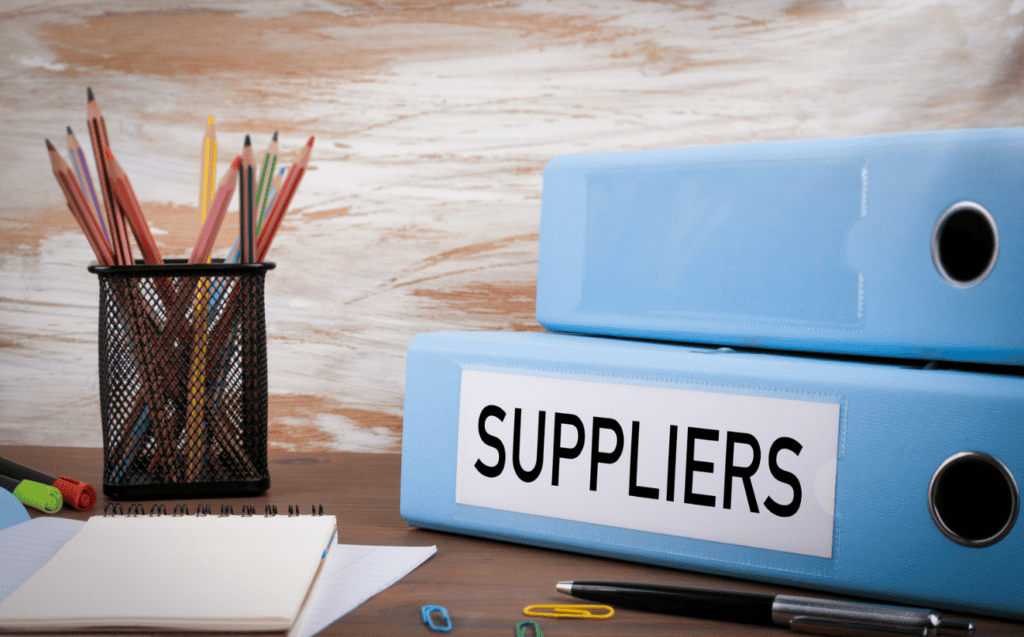Sourcing is vital to all businesses, big and small. Understanding the essentials to finding and developing a successful supplier relationship can significantly impact your success.
Table of Contents
Whether you are ready to explore the sustainable world of green packaging supplies or hope to expand and diversify your business offerings, understanding the various steps in acquiring a reliable and trustworthy supplier is crucial to success.

Supplier Sourcing Guide: Types of Sourcing
Four main types of sourcing need to be considered before you begin your search for the perfect supplier match.
Single
Single sourcing is when a company works with only one main supplier out of a pool of options who can provide necessary goods or services. This strategy is often used to build and maintain a long-term partnership with a trusted supplier.
The benefits of single sourcing include cost-saving bulk purchasing, streamlined supplier management, and other potential opportunities for further collaborations. However, it does carry risks like limited negotiation power or crippling supplier disruptions.

Sole
Sole sourcing occurs when only one supplier can fulfill a company’s specific requirements. This could be because of the supplier’s available technology, expertise, or unique products that cannot be found through other sources.
In these cases, businesses will have no alternative but to source exclusively with the sole supplier. While this method carries many advantages, like specialized products or services, customizable solutions, and a solid working relationship, it also typically results in limited competition that results in higher costs or dependence on one supplier.
Co-Sourcing
Co-sourcing is partnering with an external supplier or provider to collaborate with a company’s internal team on a specific project or task. This is often viewed as a joint venture, where the supplier works alongside the company’s team, equally sharing resources, responsibilities, and expertise.
The benefits of co-sourcing allow businesses to maximize external capabilities, access specialized skills, and effectively navigate temporary workload spikes. Furthermore, it can improve efficiency, speed up a project timeline, and introduce fresh perspectives.
Dual
Dual sourcing involves working with two suppliers to provide the same product or service. This type of sourcing aims to diversify the supply base, create supplier competition, and mitigate risks.
Having multiple suppliers can reduce the negative impacts of supplier disruptions, negotiate better prices and terms, and ensure a consistent supply. However, managing relationships with multiple suppliers requires effective monitoring and coordination.
Purchasing software can streamline these sourcing strategies by automating supplier comparisons, contract tracking, and ongoing performance monitoring.
Supplier Sourcing Guide to Success
When deciding on a new supplier, six key steps must be followed to build a successful and lasting business relationship.
Establish Your Needs
Take the reins of your supplier sourcing process by establishing your needs. Before you start looking for suppliers, it’s crucial to have a clear understanding of what you need from them. This includes factors like specifications, requirements, budget, timeline, and expectations.
Furthermore, considering your long-term goals and how you expect your suppliers to support them can further narrow your options and allow you to focus only on the most suitable choices for your business.
Conduct Research
When your needs have been clearly defined, it is time to start researching potential suppliers. Many different sources of information are available, including online directories, trade shows, referrals, industry associations, and social media platforms.
When conducting your research, it is essential to include sources that can attest to the reputation, credibility, and track report of the supply companies you are interested in.
This process includes verifying their legal status, financial stability, and ethical standards. In addition, you should read online reviews and testimonials and contact any references provided for further information.
Evaluate & Compare
Once you have compiled your list of potential suppliers, you must evaluate each supplier based on your needs and established criteria. You can use various methods in your evaluation, including requesting quotes, proposals, samples, or in-person demonstrations.
You will also need to communicate directly with the suppliers, asking the appropriate questions to better understand their availability, capacity limits, lead time, payment terms, delivery options, and post-sale services, to name a few.
Once you have gathered the necessary information from each option, you can compare them against one another, identifying the supplier who will best suit your business needs and offer you the best value for money.

Negotiate a Contract
Once you have selected the supplier you hope to work with, you will need to establish and, if necessary, negotiate a contract that is beneficial to both parties. Your primary goal should be to get the best possible deal while maintaining a respectful and fair relationship with the supplier.
It is essential to ensure that everything stated in your contract is clear and covers the most important aspects of your agreement, which typically include the scope, price, delivery, payment methods, warranties, liability, and dispute resolution. This contract should be assessed regularly and updated as needed.
Manage & Monitor Your Partnership
Once both parties have signed the final contract, you will need to begin managing and monitoring the relationship and dealings between your company and the supplier. You should prioritize regular and effective communication with them, discussing feedback, suggestions, and support from either side.
Furthermore, you should track and measure their performance and compliance with the contract and your expectations. Any issues and changes should be addressed and dealt with promptly and professionally, and you should recognize and reward their achievements and contributions to your business.
Review for Improvements
The final step in building a healthy and productive relationship with a supplier is evaluating your partnership’s effectiveness and efficiency identifying strengths, weaknesses, opportunities, and possible threats.
Seek feedback from internal and external sources, including customers, employees, and suppliers themselves. Benchmark your performance and results against your set goals and industry standards to understand and judge your progress fairly.



